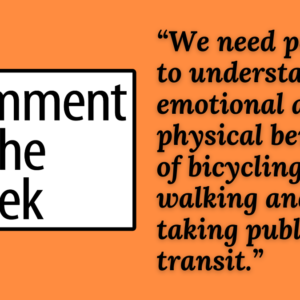The Oregon Bicycle and Pedestrian Plan includes Health as its sixth goal. It is 1/2 page in the summary and barely 1 full page in the latest Draft (Feb 2016). Health is on the backburner; Active Transportation deserves better.
The Plan continues a lip service to integration of Health & Transportation . In 2014, an Oregon white paper on Health and Transportation initiated a discussion about Health but also included other states’ opinion of health as a factor in transportation. The Plan truncates those results of health to feel-good language:
promotion of biking/walking to improve air quality and to give opportunity for physical activity.
The Plan could declare populating ODOT directly with resources regarding Health. The heart of health & transportation is asking do we have the right people at the table making decisions? I would suggest the Bicycle and Pedestrian Plan respond by including Health at every table as more than a memorandum of understanding.
Several levels of ODOT would benefit with an explicit Health person as part of decision making. First, Oregon Bicycle and Pedestrian Advisory Committee has no Health designated member. Second, every Area Commission of Transportation should invite their regional health authority person to participate as a non-voting member to respond to multimodal issues involving community safety and health. Lastly, the Oregon Transportation Commission should have a liaison directly with the Oregon Health Authority regarding roadways within communities for health and safety.
Health Analysis should be an integral part of the ODOT at the Transportation Development Division. This is an example which illustrates the intersection of Health and Transportation.
Mapping by Dept of Motor Vehicle (DMV) includes license weight/height information. This can reveal trends and can alert us to the danger of our obese society. Eugene has these lovely maps regarding obesity. Licensed drivers’ BMI is mapped here in colors. BMI stands for body mass index (a calculation based on weight & height). There is a mixed opinion about its use, accuracy of health prediction, value, etc. But I tend to think of this map as an high altitude measure of obesity not a precision data set (e.g. there are gender differences of weight/ height reporting). In general, 18.5 BMI is underweight, up to 24.9 is normal (blue) and 25 to 29 (yellow is overweight and 30+ (red) is obese. Guess where the overweight/obese live?
This information is important to active transportation and to the health of population.
Potential simple questions from this map posit:
Is there a relationship with long blocks (more in the suburbs/cul de sacs)and BMI?
Is there an “encouragement” of obesity/overweight for people living in the suburbs?
Is there a discouragement of activity for people in the suburbs?
Is there a zoning issue~stores are islands far from where people live?
Is there an effect on children who have to be driven to a school throughout their education that reinforces our sedentary society?
The inclusion of health information in transportation and zoning can integrate transportation policies with health directives and values that will benefit our society.
A silent issue is transparency of information. In showing these graphs to many people at ODOT over the past 6 years, privacy is always raised. The Plan could confirm that ODOT information is public record for the purpose of planning and analysis. Establishing a rule transparency is important for all players making decisions. Yes, perhaps this is outside the bounds of a transportation engineer. But this kind of information reinforces integration of all information and also public education. And this in turn helps us understand ourselves as travelers be it pedestrian, bicyclist, or motorist.
Next: Gem in the attic
— Only paying subscribers can post in this section, but everyone can read and comment. Learn more about our subscription program here.






Thanks for reading.
BikePortland has served this community with independent community journalism since 2005. We rely on subscriptions from readers like you to survive. Your financial support is vital in keeping this valuable resource alive and well.
Please subscribe today to strengthen and expand our work.